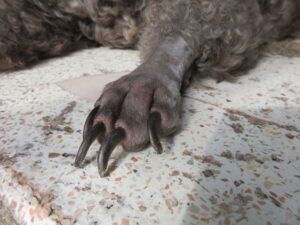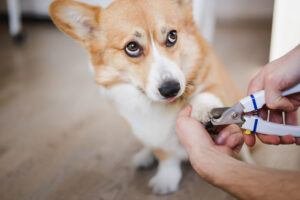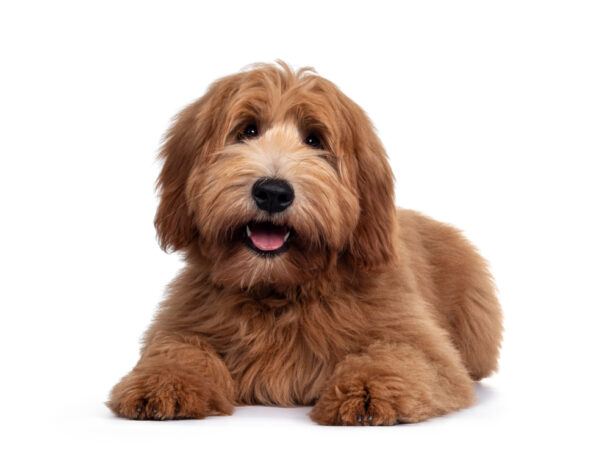LifeWithMyDogs is supported by our audience. When you purchase through one of our links, we may earn a small affiliate commission. As an Amazon Associate I earn from qualifying purchases. Your cost is not affected.
**********
Trim nails show clear evidence of your dog’s good health and cleanliness. Indeed, they are an essential aspect of dog grooming. Squeamish owners can hire a professional groomer to handle the job, but dog nail clipping is an easy technique if done correctly. Wondering “when should I cut my dog’s nails?” Once your dog’s nails begin to touch the ground, it’s a good idea to clip them. A dog’s nails, like human nails, will continue to grow until they curl outward or, worse, inside.

Nails in need of cutting
Because nail clipping is stressful for some dogs, begin touching and trimming your puppy’s feet when they’re small, so they develop acclimated to the procedure. While some dogs will sit in your lap or on a table while their nails are clipped, others may require restraint.
Why Cut My Dog’s Nails
According to the American Society for the Prevention of Cruelty to Animals (ASPCA), a dog’s paws serve as insulation, shock absorbers, and tissue protection. Overgrown nails can limit a dog’s mobility since they rely on their feet for exercise, comfortable movement, and certain sorts of play. When you observe a dog’s dewclaw curled into the skin, you may experience discomfort and even agony as a result of untrimmed nails. Nails that have grown too long can lodge themselves in a dog’s paw, causing pain for your dog and making removal more difficult the longer you wait.
How to Trim a Puppies Nails
Regular nail clipping is an essential aspect of a puppy’s grooming routine. Allowing your dog’s nails to become too long might cause his toes to spread, putting stress on his ankle joints. If this happens, he may have trouble walking around. Long nails make a dog more likely to harm flooring, furniture, and people.
Most owners are nervous about trimming their dog’s nails, but if you start doing it soon after you bring their puppy home, you’ll discover it’s simple, and you’ll get your puppy used to staying still for this portion of the grooming procedure, so it’s no longer a chore.
Before You Begin
Begin by trimming only the very tips of his nails. It will give your puppy the experience of getting his nails cut while also allowing you to gain confidence. If you’re still worried about trimming your pup’s nails, you may go to a professional groomer or ask your veterinarian to instruct you how to do it properly.
It’s advisable to cut your puppy’s nails once a week and only use professional nail clippers explicitly created for dog nails (they are markedly different from human or cat nails). You might even wish to enlist the assistance of another individual the first few times. While you cut the puppy’s nails, the other person can keep the dog still. There will be no need to confine your dog after he has grown accustomed to this type of grooming.

The Tools of the Trade
Over the years, I’ve used a variety of grooming tools including all types of nail cutters and trimmers. Some work best on some dogs while others for other dogs. For some, it’s a personal preference of the groomer. But the basic rules apply.
The types of nail clippers are:
- Scissor
- Guillotine
- Grinder
I first learned using the Guillotine style and so naturally found it easier than scissors when I first tried the scissor type. However, over time, I’ve found some reasons to love each in their own way.
-
Scissor
The scissor-type works especially well with larger dogs. Large dogs have thick claws and the scissor type, when sharp, slices through quite easily. Also, the grip on these clippers is easier on the hand when cutting those thick nails.
That said, I know many use the smaller scissor nail cutters on small dogs with good success. Many find they cause smaller nails to splinter and break more easily. This depends in part on the type of nail the dog has. Also, soaking helps (see my tips below) It’s still a matter of preference and also what you have become used to using.
- Pros of the Scissor-Type
- good for larger dogs
- easy to use
- comfortable grip
- cuts with precision
- Cons of the Scissor-Type
- sometimes more difficult with nervous or jittery dogs
- can cause breaking and splintering of the nails
- if you have dogs of various sizes, you might need more than one clipper
-
Guillotine
Using the guillotine clippers on your small to medium dogs works quite well for basic cuts. You might need to file the edges as these cutters sometimes leave sharp edges. However, many find they are easier to use and produce fewer splinter issues.
Can they be used on large dogs? Absolutely! When I first started grooming my own dogs, I was a pre-teen. All we had were guillotine clippers–the original Resco brand– and we used them on our beagles as well as my collies. In fact, they were used on my sister’s St Bernard, too. They work.
If you plan to use this type for larger dogs, look for the jumbo model. For smaller dogs, you have smaller-sized options available.
- Pros of the Guillotine
- easy to use
- less likely to cause breaking and splintering
- can be used on dogs of all sizes (with the right size clipper)
- Cons of the Guillotine
- cuts may be jagged and need filing
- some people find it awkward to use
- if you have dogs of various sizes, you might need more than one clipper
-
Grinder
In recent years, we’ve seen many people move toward the Grinder Trimmer option. Similar to a hand-held rotary tool for crafts and utility purposes, this acts like a true grinder, sanding or grinding the nail to the perfect length. Since it doesn’t actually cut, it offers less chance of injury in that way. However, the grinding action can certainly cause problems if it slips and hits the paw or pad. Additionally, it may be more challenging to use on dogs with a lot of hair on their feet, such as the Old English Sheepdog or a Maltese.
While most dogs do adapt to the low noise and low vibration, some dogs are much more sensitive and require a lot of training to adjust. We find that by running the tool near the dog but not touching at first helps. Then, try just one nail. If he seems to startle and become nervous, let one nail at a time be enough. In time, you will be able to do all the nails with ease.
- Pros of the Grinder
- easy to use
- one tool for all sizes of dogs
- all types of nails including thin or thick
- cordless
- Cons of the Grinder
- may take longer to complete all 4 feet
- some dogs take longer to adjust to the use of it
- challenging for dogs with feathering or hair on the feet
- initially more expensive
Getting Started
Place your puppy’s paw in your palm and grip each toe with your index finger and thumb to trim his nails. Hold the toe firmly rather than squeezing it. Give the puppy the instruction “No, stay!” if he attempts to pull his paw away from you or strives to get free. Praise him instantly if he obeys your command. With the other hand, hold the nail clipper. This posture will allow you to trim your nails more precisely and prevent you from cutting them too short.
It’s crucial to stay away from the vein that runs halfway through the nail. This vein is known as the “quick,” and it’s easy to notice in white or virtually translucent nails. In the same way, human nails have a white region above the fingertip and a light pink extension of the toe below it, dogs’ nails have a white, nerve-free section above the toe and a light pink extension below it. Avoid cutting into the pink area of the nail since it contains nerve endings and blood.
The quick may be more difficult to notice if your puppy’s nails aren’t clear — they might be brown, grey, or black. You’ll only need to be extra cautious not to cut through it. If this is the case, you should only trim the tips of your nails once a week. Be prepared for some blood if you cut the quick by accident. It is not a life-threatening condition, but it can progress to infection if not treated appropriately. To stop the bleeding, use a little quantity of styptic powder or alum.
The Process
- Find a comfortable work area. Groomers have the dog on a table at a comfortable height. You might prefer to sit on the floor or a chair with your dog. Whatever is comfortable and allows you to perform the task is the best solution.
- First, assemble your trimmers or grinder, your jar of styptic powder or pads in case you cause bleeding, and a helper. Once your dog is used to nail trims, you may not need the assistant to help hold but for now, consider having a helper to start.
- Hold the dog’s paw firmly but gently. Avoid squeezing but make sure you have a hold. Keep all fur away from your cutting area.
- If needed, extend the nail by pushing up slightly and backward on the pad.
- Note the amount of growth on the nail. Look for the quick to ensure you do not cut into it.
- Clip only the tip of the nail. Make your cut straight across, not into the nail bed.
- If the nail is dark colored, make a cut, then look for a chalky white ring where you have just cut. When you are nearly at the quick, that ring will be close to the outer edge of the nail.
- When you are finished, pet your now manicured pooch and provide him a treat!
How to Cut a Curled Dew Claw Dog
Most dogs despise it, and their owners aren’t any more enthusiastic about it – yet regular claw cutting is a requirement. Regular grooming to ensure their nails aren’t too long is crucial for keeping a dog healthy and happy, much like food, water, shelter, and exercise. If your dog’s nails have gone too long between manicures, they may curl inward or sideways. Keep your dog’s nails at a moderate length and cut them as soon as you observe curling to keep him walking pain-free.
If you discover your dog’s nails are long and curled, or if you notice a nail that has curved into the skin, you must act quickly. Fortunately, trimming a dog’s nails is relatively simple if your dog stands still long enough. Make sure you have nail clippers with a scissor-style design so you can reach beneath curled or embedded nails.
Begin clipping your dog’s nail towards the tip, keeping the clippers at a straight angle to the nail. Trim the nail a tiny amount at a time until it is no longer curled under, and stop when you reach close to the quick of the nail since more trimming might cause bleeding and pain.
Use scissor-style clippers to trim your dog’s nail if it has become trapped in her paw. It will leave the tip of the nail caught in the paw pad. In most circumstances, you should be able to pull or wiggle the nail tip out gently; however, obstinate nails may require the use of a basic instrument such as tweezers or needle-nose pliers. Once the nail is taken off, the paw will most likely bleed, so wash it with soap and water before washing it clean with a pet-safe antiseptic or a tiny quantity of diluted hydrogen peroxide or alcohol.
How Long Should a Dog’s Claws Be
Your dog’s nails should be long enough to be seen, of course. But they should not be so long that they extend past the paw. Keep in mind that if your dog has long hair, the nails may be difficult to see. However, if your dog’s nails extend over the bottom of the paw pad, you know they’re too long. You may also search for the nail quick which is the blood vessel that feeds the nail. Use it as a reference to determine how short your dog’s nails should be trimmed. Nerves and blood supplies comprise the quick of the nail. Always try to avoid cutting into your dog’s quick. If you do, however, it will probably bleed and he will be uncomfortable. Think of it as cutting your own nail a bit too short. It hurts, but it isn’t life-threatening.
It is one of the reasons why it’s crucial to keep your nails trimmed regularly. The quick portion of your pet’s nail grows together with the nail, itself. Thus, by keeping the nail short, you ensure the quick remains short too.
Dog nails that have grown too long may curl over or even into the pad.
Avoiding this type of overgrowth is crucial as it can cause serious problems.
Don’t forget about the dewclaw as well. Many dogs have a nail slightly above the foot on the inside of the leg. It’s known as the dewclaw. Most dogs are born with these on the front legs and a few will also have them on the back legs. Some breeders have them removed from pups to avoid problems with them catching on something and possibly tearing. However, if your dog has them, know that it will not wear down on the pavement or during walks since it does not touch the ground. These dewclaws still need to be kept short with regular trimming.

Using a grinder to trim dog’s nails smoothly
Signs Your Dog’s Nails Are Too Long
Let’s look at some signs that your dog’s nails are too long if you’re not sure if it’s time for a cut.
Your Dog’s Nails Scratch You.
Sometimes when a dog wants attention, he paws at you. Normally, this is merely a paw. However, if your dog’s nails scratch you when he touches you, look for excessively long nails. You usually won’t feel his nails when they’re the right length and filed down.
Your Dog’s Nails Click on the Floor.
For homes with hardwood or tile floors, the sound of clicking nails when he walks indicates that it’s time for a nail trim.
Your Dog Looks Like He’s Tip-Toeing.
Your dog might walk gently or “tip-toe” with his nails on the ground and his paw raised. Most likely, his nails show overgrowth. Over time, this change in his walk can cause health issues, too.
Your Dog’s Nails Curl Over His Pad.
The dog’s nails should be the same as the level of his paw. It’s time to cut his nails if they’re curling over his pad. In fact, they should not curl at all. Because the dewclaw does not get worn down by ordinary walking, this is very crucial.
Your Dog’s Paw Slides on the Floor.
Your dog’s claws are certainly producing a lot of instability on the floor if he’s sliding about. It happens when his nails are highly overgrown, and his paw isn’t touching the ground for him to grasp. Other injuries might result from his instability and sliding, such as a joint luxation or a hairline fracture.
Your Dog is Limping.
Check to determine whether your dog’s nails are at the proper length if he appears to be limping or walking uncomfortably. It’s possible he’s in discomfort and favors one leg over the other.
Your Dog Licks His Paws a Lot.
Some dogs lick their paws for a variety of reasons, including discomfort. However, if his nails grow excessively long, a trim may be necessary.
Your Dog’s Nail Bed is Bleeding or Red in color.
If your dog’s nail bed is bleeding or red, it might be an indication of an infection. His nails could be in desperate need of a trim or some significant attention.
Know how to care for your dog’s nails
Proper nail care allows your pet to walk, run, and move about freely. When your dog’s nails grow overly long, they cause the foot to be at an awkward angle. It places uneven pressure on the toes, causing soreness and tenderness in the nail beds. Long nails break and splinter more easily, too. If left untreated, you might consider a visit to your vet for expert assistance.
Do you do routine nail trims on your dog? Or do you use the expertise of a groomer or your vet? Please leave your questions and comments below. And we enjoy seeing pictures of your fur friends, too!
Read More

